

Cheers: Belongingness and Para-Social Relationships. In yesterday's All Things Considered, NPR commentator Jake Halpern questions why you feel like you have a relationship with the characters in your favorite TV shows.

His answer: "That's because you do. " This idea is interesting not just to help us understand how we relate to imaginary characters, but also to correlate with our own understanding of Dunbar Number relationship limits and how they might relate to this concept. In his commentary, Bostonian Jake Halpern considers two academic ideas, "belongingness theory" and "para-social relationships", and how they affect the relationships we develop with television characters. He puts it all in the context of the 1990s TV show Cheers: "My preoccupation with Cheers the Bar puzzled me until I stumbled upon a rather obscure but quite fascinating academic notion called belongingness theory.The argument goes something like this: in ancient times humans who stuck together increased the chances that they would survive and reproduce.
Dunbar Triage: Too Many Connections. As someone who now has over 171 professional "connections" in my LinkedIn Profile, 198 "friends" on Orkut, many more non-intersecting friends and acquaintances on Tribe.Net, LiveJournal, and other social networking services, as well as a plethora of correspondents that I only interact with via email, I am trying reconcile a mismatch between my connections and my own Dunbar Number.

How do I maintain meaningful relationships with over 300 people? Venture Capitalist Jeff Nolan relates similar concerns: "It strikes me that the social networking theory holds that the more volume you have, the bigger your network will become by introducing degrees of separation roughly along the lines of Metcalfe's Law. I disagree, human networks do not grow in value by multiplying, but rather by reduction.
For me, it's the quality of relationships that enhances my professional and personal life, not the sheer numbers. " I offer here the beginning of that discussion. The Cultural Strategies. GroupSatisfaction.jpg 767 × 523 Pixel. Dunbar Number & Group Cohesion. There is some more excellent research this week by Nick Yee and Nicolas Ducheneaut in the PlayOn blog.
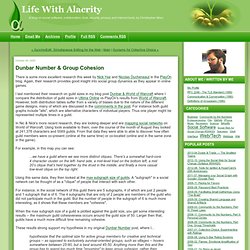
Again, their research provides good insight into social group dynamics as they appear in online games. Dunbar & World of Warcraft. In my initial blog entry on the Dunbar Number I presented some statistics on group sizes based on the online game Ultimata Online.
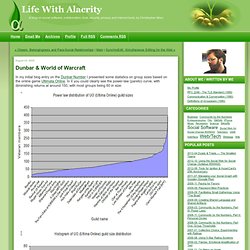
In it you could clearly see the power-law (pareto) curve, with diminishing returns at around 150, with most groups being 60 in size: More recently, Nick Yee and other researchers at the PlayOn Blog have been researching the behaviors of players in the popular World of Warcraft online game. At my request, they sampled guild sizes over a one-week period, and prepared similar graphs: The Magical Number Seven, Plus or Minus Two. The Magical Number Seven. Home | Site Map | Watch | FAQ | History | Store | Contact originally published in The Psychological Review, 1956, vol. 63, pp. 81-97 (reproduced here, with the author's permission, by Stephen Malinowski) Belorussian translation German translation.
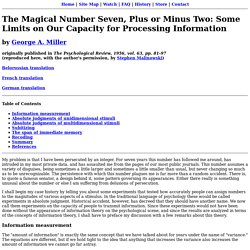
ChristopherA's workinggroup Bookmarks on Delicious. Community by the Numbers, Part One: Group Thresholds. We often think of communities as organic creatures, which come into existence and grow on their own.
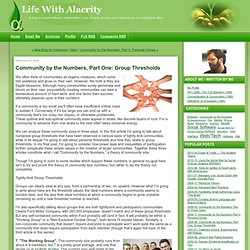
However, the truth is they are fragile blossoms. Although many communities surely germinate and bloom on their own, purposefully creating communities can take a tremendous amount of hard work, and one factor their success ultimately depends upon is their numbers. If a community is too small you'll often have insufficient critical mass to sustain it. Conversely, if it's too large you can end up with a community that's too noisy, too cliquey, or otherwise problematic. Community by the Numbers, Part II: Personal Circles. In my previous post, I talked about the limits on sizes of tightly-knit communities.
These group limits are closely related to a number of interesting personal limits, and are often confused with them. Community by the Numbers, Part III: Power Laws. In my first article in this series I talked about community numbers: how the sizes of groups ultimately affect their success (or failure).
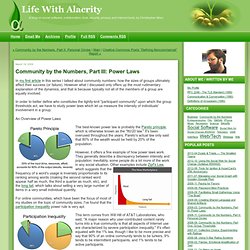
However what I discussed only offers up the most rudimentary explanation of the dynamics, and that is because typically not all of the members of a group are equally involved. In order to better define who constitutes the tightly-knit "participant community" upon which the group thresholds act, we have to study power laws which let us measure the intensity of individuals' involvement in a group.
The Dunbar Number as a Limit to Group Sizes. Lately I've been noticing the spread of a meme regarding "Dunbar's Number" of 150 that I believe is misunderstanding of his ideas.
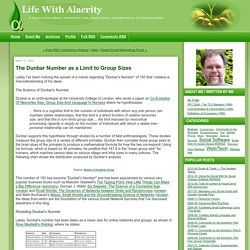
The Science of Dunbar's Number Dunbar is an anthropologist at the University College of London, who wrote a paper on Co-Evolution Of Neocortex Size, Group Size And Language In Humans where he hypothesizes: ... there is a cognitive limit to the number of individuals with whom any one person can maintain stable relationships, that this limit is a direct function of relative neocortex size, and that this in turn limits group size ... the limit imposed by neocortical processing capacity is simply on the number of individuals with whom a stable inter-personal relationship can be maintained.